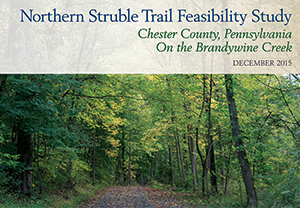Northern Struble Trail Feasibility Study
The primary purpose of the Northern Struble Trail Feasibility Study was to investigate the feasibility of extending the Struble Trail along the 13.5 mile abandoned Waynesburg Branch of the Pennsylvania Railroad corridor. The three main factors evaluated towards the development of the study recommendations included:
- Physical Feasibility: the existing conditions of the land;
- Legal Feasibility: the base property ownership of the corridor; and,
- Public Participation: what we learned from the locals and adjacent landowners to the rail corridor. Five (5) public meetings were held and a survey was mailed to the 170 adjacent landowners.
The Northern Struble Trail Feasibility Study provides recommendations for 6 sub-segments of the 13.5 mile corridor labeled A-F as depicted in the narrative report and executive summary's Recommendation Summary Map.

The study determined it is generally feasible to extend the existing 2.6-mile Struble Trail an additional 4.7 miles to Burgess Park, shown as Segments A and B. Both Segments A and B are physically feasible for trail development, yet only Segment A is currently legally feasible. Chester County and Marsh Creek State Park own the majority of the Segment A corridor in fee, whereas Segment B is entirely privately owned.
The 3.7 mile 'Segment A' trail extension would allow for all users permitted on the existing Struble Trail AND provide an adjacent bridle path for equestrian users that would access the trail from Marsh Creek State Park.

The following are the benefits of the Struble Trail 'Segment A' extension:
- More than doubles the length of the existing Struble Trail from 2.6 miles existing to 6.3 miles;
- Extends development of the Circuit - Greater Philadelphia's Regional Trail Network;
- Directly connects the Struble Trail to Marsh Creek State Park;
For the remaining segments, Segment D is the only other portion of the corridor currently feasible for multi-use trail development. This 2.9 mile corridor could be a stand-alone trail facility between Glenmoore Village and the Wyebrook Farm. Trail development is neither physically nor legally feasible within Segments C and F due to the former rail corridor having reverted back to adjacent landowners once rail service was abandoned, thus fragmenting both the ownership and physical conditions of the corridor. Segment E is owned in fee by Chester County, but is only recommended to be developed as a future extension if a trail system should be developed by Honey Brook Township to which the County could connect.
The Northern Struble Trail Feasibility Study was funded by a PA Department of Conservation and Natural Resources (DCNR) Community Conservation Partnerships Program (C2P2) grant and the William Penn Foundation. The document was prepared by both the Brandywine Conservancy and the Chester County Planning Commission in collaboration with the Chester County Parks and Facilities Department between July 2014 and December 2015.
 Documents
Documents

